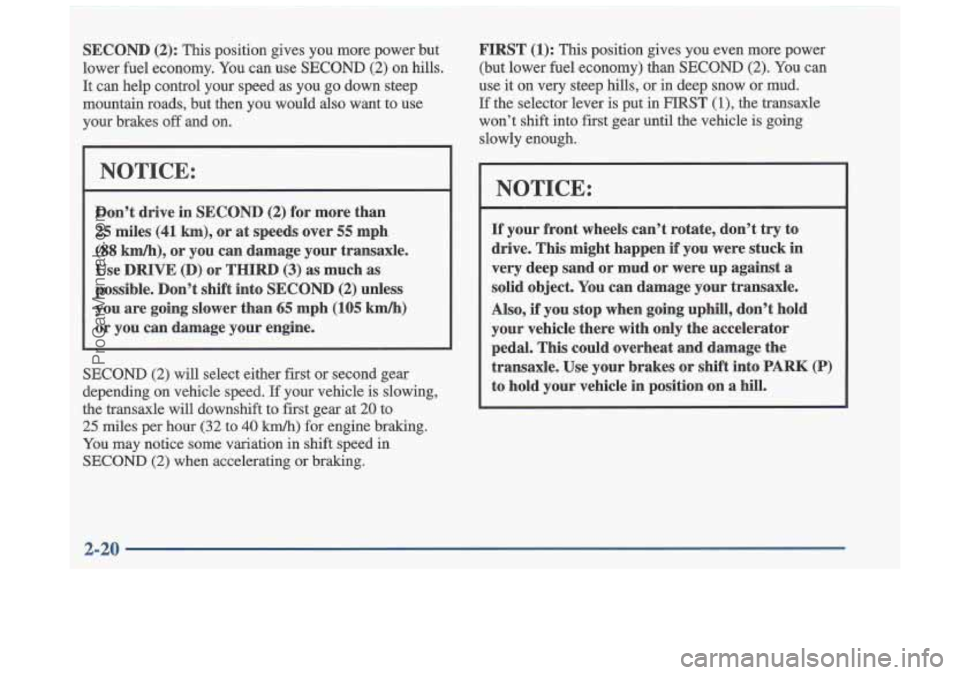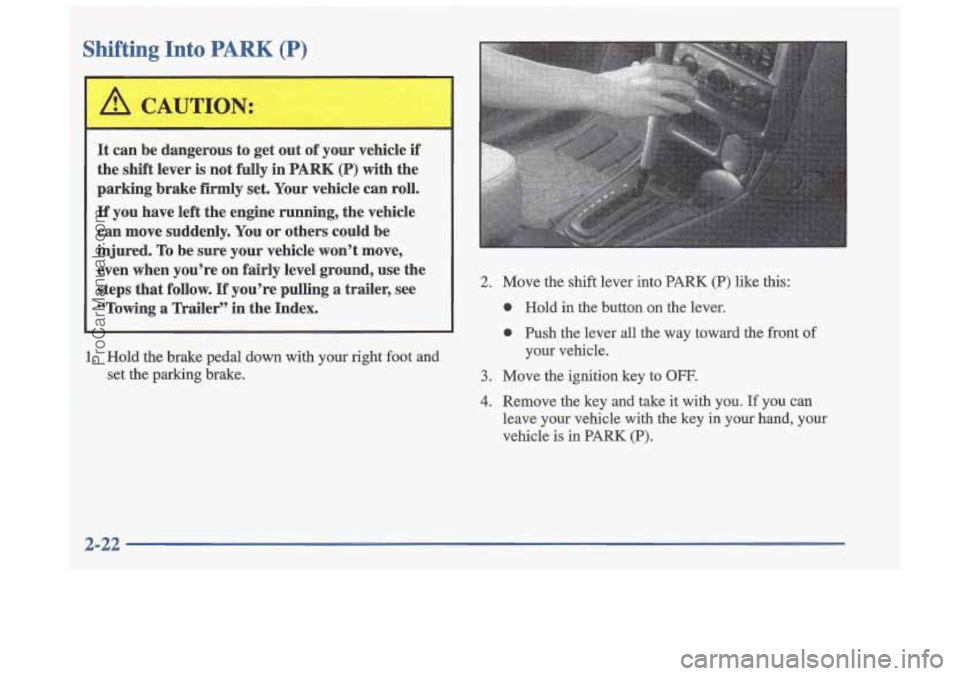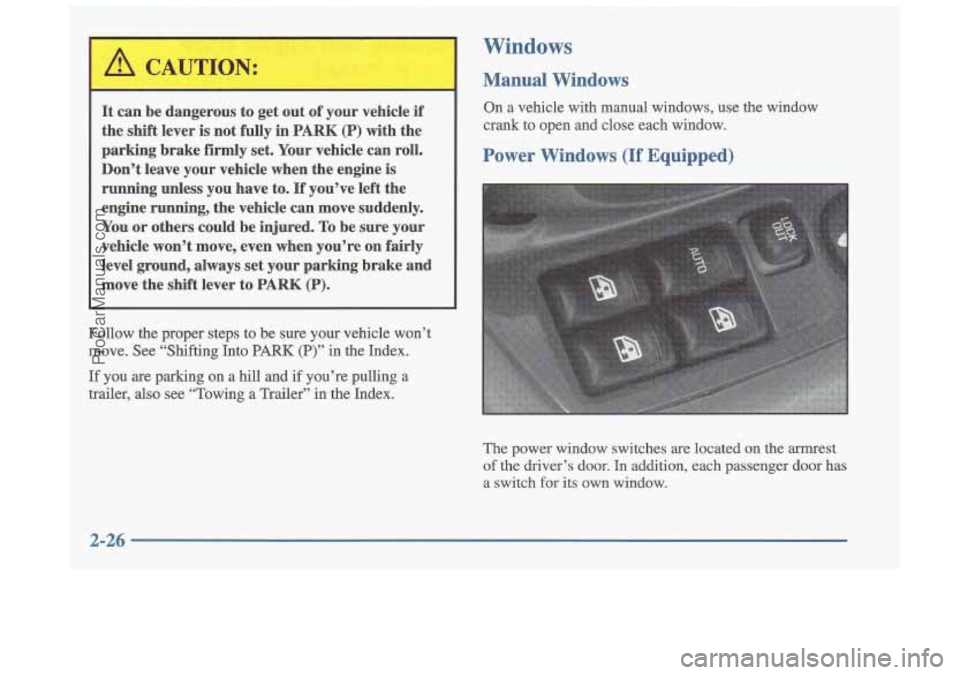1997 OLDSMOBILE CUTLASS engine
[x] Cancel search: enginePage 75 of 353

Ensure the shift lever is fully in PARK (P) range
before starting the engine. Your Oldsmobile has a
brake-transaxle shift interlock. You have to apply your
regular brake before you can shift from PARK (P) when
the ignition key is
in ON. If you cannot shift out of
PARK (P), ease pressure on the shift lever
-- push the
shift lever all the way into PARK (P)
-- as you maintain
brake application. Then move the shift lever into the
gear you wish. (Press the shift lever button before
moving the shift lever.) See “Shifting Out of PARK
(P)”
later in this section.
REVERSE (R): Use
this gear to back up.
I 1
I NOTICE:
Shifting to REVERSE (R) while your vehicle is
moving forward could damage your transaxle.
Shift to REVERSE (R) only after your vehicle
is stopped.
To rock your vehicle back and forth to get out of snow,
ice
or sand without damaging your transaxle, see “If
You’re Stuck:
In Sand, Mud, Ice or Snow” in the Index. NEUTRAL
(N): In this position, your engine doesn’t
connect with the wheels.
To restart when you’re
already moving, use
NEUTRAL (N) only. Also, use
NEUTRAL (N) when your vehicle is being towed.
Shifting out of PARK (P) or NEUTRAL
(N) while
your engine is “racing” (running
at high speed) is
dangerous. Unless your foot
is firmly on the
brake pedal, your vehicle could move very
rapidly. You could lose control and hit people or
objects. Don’t
shift out of PARK (P) or
NEUTRAL
(N) while your engine is racing.
NOTICE:
Do not shift out of PARK (P) or NEUTRAL (N)
with the engine racing. Your transaxle can be
damaged by doing this and will not be covered by
your warranty. Shift your transaxle according to
the instructions in this manual.
ProCarManuals.com
Page 77 of 353

SECOND (2): This position gives you more power but
lower fuel economy. You can use
SECOND (2) on hills.
It can help control your speed as you go down steep
mountain roads, but then you would also want to use
your brakes
off and on.
NOTICE:
Don’t drive in SECOND (2) for more than
25 miles (41 km), or at speeds over 55 mph
(88 kmh), or you can damage your transaxle.
Use DRIVE (D) or THIRD
(3) as much as
possible. Don’t shift into SECOND
(2) unless
you are going slower than
65 mph (105 km/h)
or you can damage your engine.
SECOND (2) will select either first or second gear
depending on vehicle speed.
If your vehicle is slowing,
the transaxle will downshift to first gear at
20 to
25 miles per hour (32 to 40 km/h) for engine braking.
You may notice some variation in shift speed in
SECOND (2) when accelerating or braking. FIRST
(1): This position gives you even more power
(but lower fuel economy) than
SECOND (2). You can
use it on very steep hills, or in deep snow or mud.
If the selector lever is put in FIRST (l), the transaxle
won’t shift into fiist gear until the vehicle
is going
slowly enough.
NOTICE:
If your front wheels can’t rotate, don’t try to
drive. This might happen
if you were stuck in
very deep sand or mud
or were up against a
solid object. You can damage your transaxle.
Also,
if you stop when going uphill, don’t hold
your vehicle there with only the accelerator
pedal. This could overheat and damage the
transaxle. Use your brakes or shift into PARK
(P)
to hold your vehicle in position on a hill.
I 2-20
ProCarManuals.com
Page 79 of 353

Shifting-Into PARK (P)
I
It can be dangerous to get out of your vehicle if
the shift lever is not
fully in PARK (P) with the
parking brake firmly set. Your vehicle can roll.
If you have left the engine running, the vehicle
can move suddenly.
You or others could be
injured.
To be sure your vehicle won’t move,
even when you’re on fairly level ground, use the
steps that follow.
If you’re pulling a trailer, see
“Towing a Trailer” in the Index.
1. Hold the brake pedal down with your right foot and
set the parking brake.
2. Move the shift lever into PARK (P) like this:
0 Hold in the button on the lever.
0 Push the lever all the way toward the front of
your vehicle.
3. Move the ignition key to OFF.
4. Remove the key and take it with you. If you can
leave your vehicle with the key in your hand, your
vehicle is in PARK
(P).
ProCarManuals.com
Page 80 of 353

Leaving Your Vehicle With the
Engine Running
It can be dangerous to leave your vehicle with the engine running. Your vehicle could move suddenly if the shift lever is not fully in PARK (P)
with the parking brake firmly set. And,
if you
leave the vehicle with the engine running, it could overheat and even catch fire. You or others could
be injured. Don’t leave your vehicle with the
engine running unless you have to.
If you have to leave your vehicle with the engine
running, be
sure your vehicle is in PARK (P) and your
parking brake is firmly set before you leave it. After
you’ve moved the shift lever into PARK (P), hold the
regular brake pedal down. Then, see if you can move
the shift lever-away from PARK (P) without
first
pushing the button.
If you can, it means that the shift lever wasn’t fully
locked into PARK (P).
Torque Lock
If you are parking on a hill and you don’t shift your
transaxle into
PARK (P) properly, the weight of the
vehicle may put too much force on the parking pawl in
the transaxle. You may find it difficult to pull the shift
lever out
of PARK (P). This is called “torque lock.” To
prevent torque lock, set the parking brake and then shift
into PARK (P) properly before you leave the driver’s
seat.
To find out how, see “Shifting Into PARK (P)” in
the Index.
When you are ready to drive, move the shift lever out
of PARK (P) before you release the parking brake.
If torque lock does occur, you may need to have
z ~- -bther
vehicle push yours a little uphill to take some of tne
pressure from the parking pawl
in the transaxle, so you
can pull the shift lever out of PARK
(P).
2-23
~~
ProCarManuals.com
Page 82 of 353

Engine Exhaust
Engine exhaust can kill. It contains the gas
carbon monoxide
(CO), which you can’t see or
smell.
It can cause unconsciousness and death.
You might have exhaust coming in if:
0 Your exhaust system sounds strange
0 Your vehicle gets rusty underneath.
Your vehicle was damaged in a collision.
0 Your vehicle was damaged when driving over
high points on the road or over road debris.
0 Repairs weren’t done correctly.
0 Your vehicle or exhaust system had been
If you ever suspect exhaust is coming into
your vehicle:
Drive it only with all the windows down to
0 Have your vehicle fixed immediately.
or
different.
modified improperly.
blow out any
CO; and
Running Your Engine While
You’re Parked
It’s better not to park with the engine running. But if you
ever have to, here are some things to
know.
r
Idling the engine with the climate control
system off could allow dangerous exhaust
into your vehicle (see the earlier Caution
under “Engine Exhaust”).
Also, idling in a closed-in place can let deadly
carbon monoxide
(CO) into your vehicle even
if the fan switch is at the highest setting. One
place this can happen is a garage. Exhaust
-- with
CO -- can come in easily. NEVER park in a
garage with the engine running.
Another closed-in place can be a blizzard. (See
“Blizzard” in the Index.)
2-25
ProCarManuals.com
Page 83 of 353

It can be dangerous to get out of your vehicle if
the shift lever is not fully in
PARK (P) with the
parking brake firmly set, Your vehicle can roll,
Don’t leave your vehicle when the engine
is
running unless you have to. If you’ve left the
engine running, the vehicle can move suddenly.
You
or others could be injured, To be sure your
vehicle won’t move, even when you’re on
fairly
level ground, always set your parkink brake and
move the shift lever to
PARK (P).
Windows
Manual Windows
On a vehicle with manual windows, use the window
crank to open and close each window.
Power Windows (If Equipped)
Follow the proper steps to be sure your vehicle won’t
move. See “Shifting Into
PARK (P)” in the Index.
If
you are parking on a hill and if you’re pulling a
trailer,
also see “Towing a Trailer” in the Index.
The power window switches
are located on the mest
of the driver’s door.
In addition, each passenger door has
a switch for its own window.
2-26
ProCarManuals.com
Page 107 of 353

Tachometer
I
4
RPM
x 1000
The tachometer shows your engine speed in revolutions
per minute
(rpm).
I NOTICE:
Do not run your engine at speeds in the red area,
or engine damage may occur.
Warning Lights, Gages
and Indicators
This part describes the warning lights and gages that
may be on your vehicle. The pictures will help you locate them.
Warning lights and gages can signal that something is
wrong before it becomes serious enough to cause
an
expensive repair or replacement. Paying attention to
your warning lights and gages could also save you or
others from injury.
Warning lights come on when there may be or is a
problem with one of your vehicle's functions.
As you
will see in the details on the next few pages, some
warning lights come on briefly when you start the
engine just to let you
know they're working. If you
are familiar with this section, you should not be
alarmed when this happens.
ProCarManuals.com
Page 109 of 353

Air Bag Readiness Light
There is an air bag readiness light on the instrument
panel, which shows the air bag symbol. The system
checks the air bag’s electrical system for malfunctions.
The light tells you
if there is an electrical problem.
The system check includes the
air bag sensor, the air
bag modules, the wiring
and the crash sensing and
diagnostic module. For more information on the air
bag system, see “Air Bag” in the Index.
This light will come on
when you start your engine,
and it will flash for a few
seconds. Then the light
should
go out. This means
If the air bag readiness light stays on after you start the
engine
or comes on when you are driving, your air bag
system may not work properly. Have your vehicle
serviced right away. The
air bag readiness light should flash
for a few
seconds when you turn the ignition key to
ON. If the
light doesn’t come on then, have it fixed
so it will be
ready to
warn you if there is a problem.
Charging System Indicator Light
The charging system
indicator light will come
on when you turn
on the
ignition, but the engine is
not running, as a check to
show you it is worhg.
Then it should go out.
If it stays on, or comes on while you are driving and
you hear
a chime, you may have a problem with the
electrical charging system. It could indicate that you
have a loose generator drive belt or another electrical
problem. Have
it checked right away. Driving while
this light is on could drain your battery.
If you must drive a short distance with the light on, be
certain to turn
off all your accessories, such as the radio
and air conditioner.
2-52
ProCarManuals.com